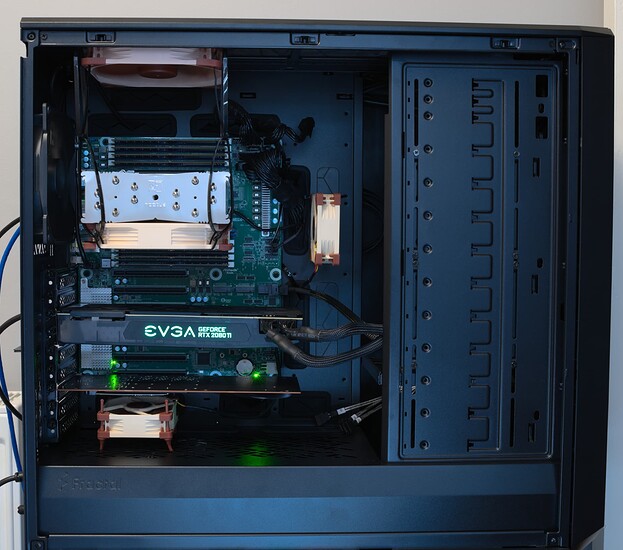I built a system with a Fractal Meshify 2 XL this week actually, but only with a single EPYC 74F3 (240W TDP) with NH-U14S TR4-SP3 cooler on an ASRockRack ROMED8-2T board. I’m using the fans which came with the case, and additionally a Noctua NF-A14 in the roof, and 2 NF-A8’s to cool the motherboard VRMs and NVMe SSDs.
I’m personally very happy with the case and the Noctua air cooler. I had no problems with cooler orientation for performance. The U14S has about 1cm of clearance with the side panel from the top of the fan, the heat pipes are shorter - about 1.5cm of clearance. My main concern was how much weight the cooler exerts on the socket, as I had heard of a mounting bolt coming out of a SP3 socket before (although could be from overtightening rather than levering), so I supported it a bit with cable ties under tension.
AIO should be even better, and less strain on the socket.
The loudest noise seems to come from my PSU (EVGA supernova 1000 T2) when the case/CPU fans are set low. With the case/CPU fans set to 100%, they are distracting, but I wouldn’t say “loud” - but of course very subjective. I can’t tell if the Noctua fans are any quieter than the Fractal Design ones, they seem very similar.
With them set at 50%, they’re a little louder than my PSU fan, noticeable only in a very quiet room. At 20%, the PSU is lowest.
The top of the case has fan mounting rails rather than just holes, so you can position top fans anywhere you’d like.
I actually did some very basic load/temperature testing a couple of days ago:
Definitions:
- Load: 0% = idle, 100% = 48 threads running POVray benchmark using performance governer
- Governor: CPU frequency scaling governor set by
cpupower on all cores.
- Case fan / CPU fan: Percentage, as set in ipmitool.
- Temperature = Highest Tccd temperature reported by Linux k10temp, 20.5°C ambient. Add/subtract a degree or two, as they fluctuate a fair amount.
- 30 minutes to stabilise temperatures between tests:
Results (hottest to coolest):
| Load |
Governor |
Case fan |
CPU fan |
Tccd °C |
| 100% @ 3.5Ghz |
performance |
20% |
20% |
63.0 |
| 100% @ 3.5Ghz |
performance |
100% |
100% |
54.2 |
| 100% on 6 core @ 4GHz |
performance |
20% |
20% |
50.8 |
| 100% on 6 core @ 4GHz |
performance |
50% |
50% |
49.5 |
| 100% on 6 core @ 4GHz |
performance |
100% |
100% |
45.8 |
| 100% on 1 core @ 4GHz |
performance |
20% |
20% |
43.0 |
| 100% on 1 core @ 4GHz |
performance |
50% |
50% |
42.2 |
| 0% @ 3.2GHz |
performance |
20% |
20% |
32.8 |
| 0% @ 3.2GHz |
performance |
50% |
50% |
30.8 |
| 0% @ 3.2GHz |
performance |
100% |
100% |
29.2 |
| 0% @ 1.5GHz |
powersave |
20% |
20% |
29.0 |
| 0% @ 1.5GHz |
powersave |
50% |
50% |
26.2 |
| 0% @ 1.5GHz |
powersave |
100% |
100% |
25.2 |
I wouldn’t expect any problems at all mounting a SSI EEB/EATX, the stand-offs are all removable if you need to reposition them (handly little tool comes in the accessory box), and there are rubber covers over the holes in the tray for cables for both standard ATX and EATX. Plenty of room at the bottom for angled front-panel connectors too.
Adding a photo so you can see my mounting hole / Noctua situation in the Meshify 2 XL:
Not sure about the cTDP question. I was under the impression that if you raised the cTDP above the limit for the model, then it just used the model limit anyway.


 ), I got up to 4.7Gb/s for 16k seq reads - that is 10+ x what the SATA link can theoretically sustain
), I got up to 4.7Gb/s for 16k seq reads - that is 10+ x what the SATA link can theoretically sustain